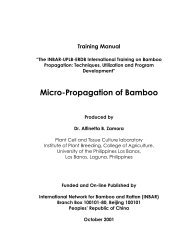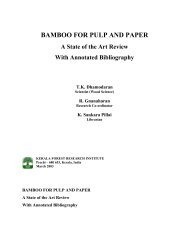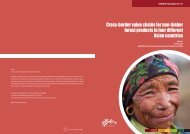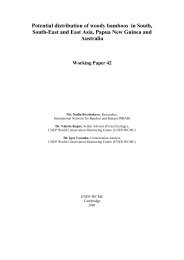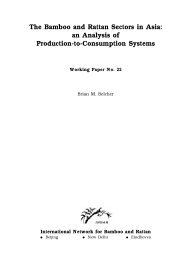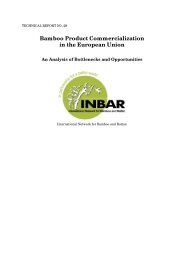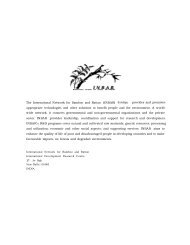Bamboo Panel Boards - International Network for Bamboo and Rattan
Bamboo Panel Boards - International Network for Bamboo and Rattan
Bamboo Panel Boards - International Network for Bamboo and Rattan
Create successful ePaper yourself
Turn your PDF publications into a flip-book with our unique Google optimized e-Paper software.
24B A M B O O P A N E L B O A R D S" Removal of slivers with epidermal layer;" Drying to less than 15% moisture content;" Application of PF resin adhesive (dipping);" Laying up;" Hot pressing <strong>for</strong> 1 1/2 to 2 hours (<strong>for</strong> 30-32 mm thick panels) at a temperatureof 110-l 60°C <strong>and</strong> a specific ‘pressure of 4-6 MPa (increasing graduallyin steps); <strong>and</strong>" Trimming.The important physical <strong>and</strong> mechanical properties are summarized in Table 9.PropertiesTable 9: Important physical <strong>and</strong> mechanical properties ofbamboo parallel gluelam (China)Variety of productSingleNon-singledirection panel direction panelDensity (kg/m 3 ) 850-l 050 840-l 050Moisture content (%) 3.6-8.7 4.0-9.3MOR longitudinal (MPa) 167-201 128-223MOR traverse (MPa) 10.3-13.8 30.4-72.0MOE longitudinal (x 10 MPa) 11.5-i 4.8 10.1-15.9MOE traverse (x 10 MPa) 3.0-4.4 2.3-4.1The main applications <strong>for</strong> this panel are <strong>for</strong> truck floors, gang planks <strong>and</strong>,less commonly, in building construction. While it is a material of great strength,its weight is a disadvantage. Moreover, it requires large quantity of resin, therebypushing up the cost <strong>and</strong> pressing time.Parallel curved gluelamThis specialty panel (locally known as ‘lamboo’) is produced in Taiwan-China<strong>and</strong> used in furniture making. The aesthetically designed curvature <strong>and</strong> attractivecolor imparted by dyeing produce highly valued panels <strong>for</strong> manufacturing furniture.Moso bamboo (Phyllostachys pubescens) <strong>and</strong> Ma bamboo (Dendrocalamus latiflows)of 8 cm diameter at the bottom end <strong>and</strong> 2.5 cm at the top were found tobe the most suited. The technology is as follows:" Conversion of culms into slivers;" Dipping in acidic dye solution at 80°C temperature <strong>and</strong> under 10 kg/m 2pressure to impart attractive color;" Preservative treatment with sodium pentachlorophenate (NaPCP) orTenalith C (<strong>for</strong>mer is found to be better);



